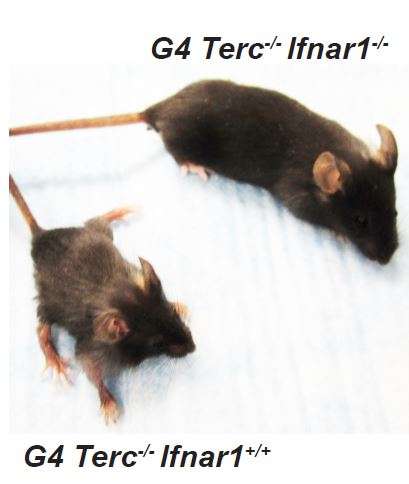Study identifies molecular link between DNA damage and premature aging

Like a beloved pair of jeans, human DNA accumulates damage over time, and older people's bodies can't repair it as well. Many scientists believe a build up of damage can cause cells to enter an irreversible dormant state known as senescence. Cellular senescence is believed to be responsible for some of the telltale signs of aging, such as weakened bones, less resilient skin and slow-downs in organ function.
DNA damage also seems to play a role in conditions called progerias, which cause premature aging. Progeria patients have mutations in genes responsible for DNA damage repair. Now researchers from the University of Pennsylvania have pinpointed a molecular link between DNA damage, cellular senescence and premature aging.
Finding the key players could lead to therapeutic targets for counteracting some of the negative effects of progerias and perhaps even forestalling the effects of natural aging.
The study, published this week in the journal Cell Reports, took a closer look at the chemical messenger interferon, a molecule that is naturally produced by the body in response to invading pathogens such as viruses. The Penn team found that interferon signaling ramps up in response to double-stranded DNA breaks and that this signaling prompts cells to enter senescence.
When the Penn researchers inactivated the interferon signaling pathways in a mouse model of progeria, however, they were able to extend the animals' lives. These mice were more fertile, had less gray hair and were larger and more robust than animals in which the interferon pathway was still active.
"Our findings imply that some of the effects of DNA damage could be managed by perhaps locally blocking interferon signaling," said Serge Y. Fuchs, senior author on the study and a professor of cell biology in Penn's School of Veterinary Medicine.
Collaborators on the study included Christopher J. Lengner, an assistant professor at Penn Vet, and Roger A. Greenberg and F. Brad Johnson, associate professors at Penn's Perelman School of Medicine. The lead authors were Qiujing Yu and Yuliya V. Katlinskaya of Penn Vet.
Though the main role of interferon is to help cells respond to pathogens, Fuchs and his colleagues began considering a growing body of evidence linking interferon to DNA damage. Previous studies had shown that people with autoimmune diseases characterized by up-regulated interferon signaling also had a build-up of DNA strand breaks. And cancer treatments such as chemotherapy and radiation, which cause DNA damage, also lead to increased interferon signaling.
"It is known that if you add a DNA-damaging agent in a high enough concentration, you will trigger interferon production," said Fuchs, who is also director of the Mari Lowe Center for Comparative Oncology at Penn Vet. "But we didn't know whether it was the DNA damage itself that led to the interferon induction or if some other aspect of the cells being killed led to the induction."
The Penn team first examined the effect of DNA damage on interferon signaling. Using an experimental technique that Roger Greenberg and his lab had earlier developed that creates double-stranded breaks in DNA without chemotherapies or radiation, the researchers found that levels of the interferon protein IFNβ and a reporter molecule tied to interferon production, IRF7, both rose.
The Penn team also found significantly higher levels of IFNβ expression in the older cells from human patients with progerias and also in mice with a mutation that causes a progeria-like condition. Using a drug that blocks IFNβ caused fewer cells to enter senescence, suggesting that senescence was triggered by DNA-damage-induced interferon signaling.
One of the reasons senescence is believed to lead to the characteristic changes of aging is that it affects stem cells, which normally serve to replenish populations of healthy cells. Earlier studies had shown that mice lacking the Terc gene, which is key to DNA repair, have lower stem cell function and age prematurely, losing fertility and developing scaly skin, gray fur and shrunken, hunched bodies. These mice also have abnormalities in their intestinal tissues, a site known to be greatly affected by stem cell failure.
As a final, in vivo test, the researchers bred Terc-deficient mice to animals also lacking an interferon receptor. These animals had reduced signs of premature aging; they were more fertile, had less gray hair, were larger and lived longer on average than mice lacking only Terc.
"We could rescue the majority of these phenotypes by abolishing interferon signaling," Fuchs said, "showing that there is a substantial role of interferon in aging that is caused by persistent DNA damage."
For people who suffer from the effects of accelerated aging after undergoing treatments such as radiation that damage DNA or who suffer from acute radiation poisoning these findings hint at novel therapies.
"Perhaps their problems could be alleviated if we neutralized interferon locally," said Fuchs.
While the current study doesn't pertain directly to normal aging in healthy individuals, Fuchs says future studies could shed light on ways to mitigate its negative effects.
"Since natural aging is connected with the DNA damage we accumulate over our lifetime and with decline in the stem cell functions, our skin is not repairing as well, our bones are not holding as well as they used to. There is rationale for the future studies on the role of interferon in normal aging."
More generally, Fuchs said, the findings highlight interferon as a sort of "guardian of the genome."
"It works at different levels: For a single cell, by protecting it from viruses that can change its genetic information; for a multi-cellular organism, by preventing genetically altered cells from proliferating via senescence; and for a society, by decreasing fertility of individuals carrying damaged genome."
More information: Cell Reports, dx.doi.org/10.1016/j.celrep.2015.03.069



















